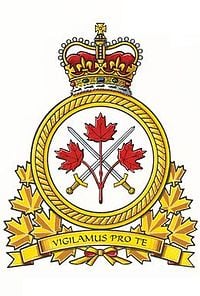 The Canadian Army (French: Armée canadienne) is the command responsible for the operational readiness of the ground forces of the Canadian Armed Forces. As of September 2013 the Army has 21,600 regular soldiers, about 24,000 reserve soldiers, and 5,000 rangers, for a total of 50,600 soldiers. The Army is supported by 5,600 civilian employees.[3] It maintains regular forces units at bases across Canada, and is also responsible for the Army Reserve, the largest component of the Primary Reserve. The Commander of the Canadian Army and Chief of the Army Staff is Lieutenant-General Paul Wynnyk.
The Canadian Army (French: Armée canadienne) is the command responsible for the operational readiness of the ground forces of the Canadian Armed Forces. As of September 2013 the Army has 21,600 regular soldiers, about 24,000 reserve soldiers, and 5,000 rangers, for a total of 50,600 soldiers. The Army is supported by 5,600 civilian employees.[3] It maintains regular forces units at bases across Canada, and is also responsible for the Army Reserve, the largest component of the Primary Reserve. The Commander of the Canadian Army and Chief of the Army Staff is Lieutenant-General Paul Wynnyk.
The name “Canadian Army” came into official use beginning only in 1940; from before Confederation until the Second World War the official designation was “Canadian Militia”. On 1 April 1966, as a precursor to the unification of Canada’s armed services, all land forces were placed under a new entity called Mobile Command. In 1968 the “Canadian Army” ceased to exist as a legal entity as the Royal Canadian Navy (RCN), Canadian Army (CA), and Royal Canadian Air Force (RCAF) were merged to form a single service called the Canadian Armed Forces. Mobile Command was renamed Land Force Command in the 1993 reorganization of the Canadian Armed Forces. In August 2011, Land Force Command reverted to the pre-1968 title of the Canadian Army History
Main article: History of the Canadian Army
Prior to Confederation in 1867, the British Army, which included both “Fencible” Regiments of the British Army – recruited within British North America exclusively for service in North America – and Canadian militia units, was responsible for the defence of Canada. Some current regiments of the Canadian Army trace their origins to these pre-Confederation militia and Fencible units. After 1867, a Permanent Active Militia was formed, and in later decades several regular bodies of troops were created, their descendants becoming the Royal Canadian Horse Artillery, the Royal Canadian Dragoons, and the Royal Canadian Regiment. Regular Canadian troops participated in the North West Rebellion in 1885, the South African War (Second Boer War) in 1899, and, in much larger numbers, constituted the Canadian Expeditionary Force in First World War
In 1940, during Second World War, the Permanent Active Militia was renamed the Canadian Army (Active), supplemented by the non-permanent militia, which was named the Canadian Army (Reserve). The Army participated in the Korean War and formed part of the NATO presence in West Germany during the Cold War. In the years following its unification with the navy and air force in 1968, the size of Canada’s land forces was reduced, but Canadian troops participated in a number of military actions with Canada’s allies, including the Gulf War in 1991 and the invasion of Afghanistan in 2001, as well as peacekeeping operations under United Nations auspices in various parts of the world
Despite Canada’s usual support of British and American initiatives, Canada’s land forces did not directly participate in the Vietnam War or the Iraq War
Sir Yes Sir Military Insignia provides most Canadian Army Regiments Bespoke Rings, Cuff Links and Dog Tags. Furthermore, if we don’t have what you are looking for please visit out Custom Ring page and have us design exactly to your requirement

